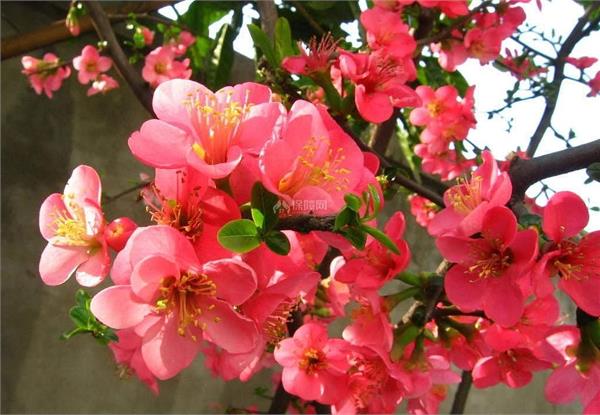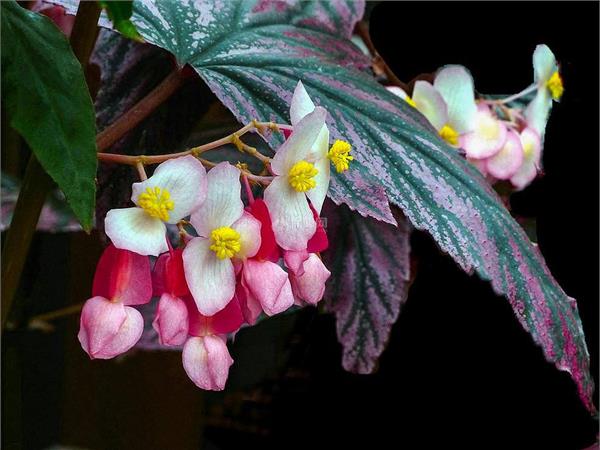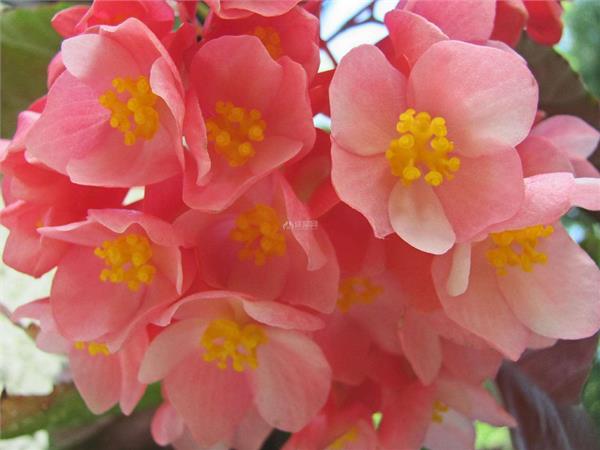Planting methods and matters needing attention of bamboo begonia
Many people like to cultivate begonia. Today, the editor introduces bamboo begonia to you. Bamboo begonia flower shape, leaf color soft, often used to decorate the living room, shop windows or decorate family windowsill, balcony, coffee table and other places. So if there are any points for attention in planting bamboo begonia, let's take a look at it with the editor.

Planting method of Bamboo Begonia
(1) plug in
The combination of basin turning and pruning was carried out from May to June. Cut 10-15 cm-long branches with 2-3 nodes as cuttings, leaving 2-3 leaves on top. Because of the size of the leaves, the leaves can be cut off, and then inserted into the substrate after the wound is shaded and dried. Under the temperature of 20: 24 X: and semi-overcast, it can take root in 25: 30 days. It can also be inserted with a single bud, cut off the stem segment with a single bud, cut off the 2GP3 of the leaves, shade 50% to 70% after insertion, and keep the soil moist and spray more water at ordinary times, but to prevent the insertion of soil from being too wet and cause bud rot, it can take root in about 20 days, mature seedlings in one and a half to two months, and the survival rate is about 90%. Can also be inserted in water, cut sturdy branches into the water, give semi-overcast conditions, and 1-2 days to change the water, after 20 days left and right can take root.
(2) ramet
Spring is combined with turning the basin. The large tufted plants were cut into several plants from the joint of the rhizome and stem, and then put on the basin respectively.
Matters needing attention in planting Bamboo Begonia

(1) temperature: like warmth, and the most suitable temperature for growth is 18 °C to 20 °C. It is a hardy species of begonia, but it still needs a temperature of more than 5 °C to survive the winter. Below 5 °C, the leaves were deciduous, and at 2 °C, a large number of leaves fell off, and the branches turned yellow and withered, but the plant could still sprout and shoot in the remaining part of the plant that was withered by cold in spring. When the temperature is more than 30 °C, the plant grows slowly and is semi-dormant. It is easy to produce fallen leaves during maintenance, so measures such as shading, foliar spraying and strengthening ventilation should be taken to reduce the temperature to form a relatively cool environment.
(2) Light: like sufficient scattered light, when the light is suitable, the stem is stout, the Internode is short, the lateral branches are many, the leaves are bright, and the flowers are colorful. Avoid strong sun exposure, when the sun is too strong, the leaves are easy to yellow, burn scorched edges, or even fallen leaves. Should not be too shady, otherwise the plant grows too long and thin, the flowering is rare or even non-flowering, and in serious cases, it will cause fallen leaves. Shading should be carried out from May to September, 50% to 60% of the light should be shaded, or the plant should be placed at the foot of scattered light. Other times need to be given sufficient sunshine, spring and autumn when sufficient light is easy to form flower buds.
(3) watering: fear of drought, like the humid soil environment, during the growth period should be fully watered, keep the basin soil moist, not too dry or too wet, too dry or too wet will affect the absorption of roots and cause deciduous leaves, buds and flowers. Avoid excessive dampness and stagnant water, otherwise the roots will rot and die. Although the plant is semi-dormant in high temperature in summer, because of the high temperature and large leaf area, watering still needs to grasp the principle of "no dry, no watering", but it is necessary to prevent waterlogging. In winter, watering is controlled to keep the basin soil slightly dry. Too much watering can easily lead to rotten roots and fallen leaves.
(4) Environmental humidity: the original habitat is under the forest or beside the ditch with high humidity, so if the environment is humid, the relative humidity of the air should not be less than 50%, and it is best to maintain 65% and 70%. When it is too dry, the edges of the leaves will roll up, turn yellowish brown and even wither. During the growing season, more water should be sprayed on the branches and leaves and around them to improve the relative humidity of the air. Spraying foliar water in summer can also reduce the temperature, which is beneficial to plant growth and flowering.

(5) fertilization: fertilizer was applied once every 10 to 15 days from April to June. Nitrogen should be the main fertilizer in the first and middle of April to promote the growth of branches and leaves. Phosphorus and potassium fertilizer should be applied during the bud period to promote bud pregnancy and flowering. Stop fertilizing during flowering. Because the root system is numerous and small, it is sensitive to the concentration of fertilizer, so we should pay attention to "applying thin fertilizer frequently" to avoid excessive concentration of fertilizer solution. Do not stain the fertilizer on the leaves when fertilizing, or they will burn. Stop fertilizing during semi-dormancy in summer. During the vigorous growth period in autumn, nitrogen-based fertilizer was applied once every 10-15 days, but nitrogen fertilizer was stopped and phosphorus and potassium fertilizer was applied twice after October to improve the cold resistance of the plant. Stop fertilizing when the winter temperature is lower than 101C.
(6) pruning: coring should be carried out at the seedling stage to promote branching and form a plump plant shape. The plant should be pruned in spring combined with turning the pot. if the plant is too high and affects the beautiful shape of the plant, the branches that are too high can be cut short and strongly to promote them to produce new branches and control the height of the plant. Because the inflorescence grows on the new branch, the senescent branches should be cut off when the new branch grows to an appropriate height, so as to promote plant renewal and facilitate future flowering. If the plant is tall and there are many inflorescences, brackets should be set up to avoid heavy pressure on the branches. After the flower fades, you should immediately cut off the remnant flowers and the branches that have bloomed, so as to promote the development of new branches and make them blossom frequently.
(7) turn the basin: turn the basin once a year, preferably after the warm spring or in September. The matrix can be prepared with rotten leaf soil, peat soil, garden soil, rice chaff ash or perlite.
(8) pest control: there are powdery mildew, blight, thrips, red spiders and other diseases and insect pests.
The above are the planting methods and precautions of bamboo begonia. Different plants and flowers have different growth habits. When planting favorite plants, you must have some understanding of the habits and characteristics of these plants. I hope the above information will be helpful to you who love plants.
(8) pest control: there are powdery mildew, blight, thrips, red spiders and other diseases and insect pests.
The above are the planting methods and precautions of bamboo begonia. Different plants and flowers have different growth habits. When planting favorite plants, you must have some understanding of the habits and characteristics of these plants. I hope the above information will be helpful to you who love plants.
Related
- Wuhan Hospital Iron Tree Blooming Result Was Instantly Frightened by the Gardener Master
- Which variety of camellia is the most fragrant and best? Which one do you like best?
- What is the small blue coat, the breeding methods and matters needing attention of the succulent plant
- Dormancy time and maintenance management of succulent plants during dormancy
- Minas succulent how to raise, Minas succulent plant pictures
- What are the varieties of winter succulent plants
- How to raise succulent plants in twelve rolls? let's take a look at some experience of breeding twelve rolls.
- Attention should be paid to water control for succulent plants during dormant period (winter and summer)
- Watering experience of twelve rolls of succulent plants
- Techniques for fertilizing succulent plants. An article will let you know how to fertilize succulent plants.



